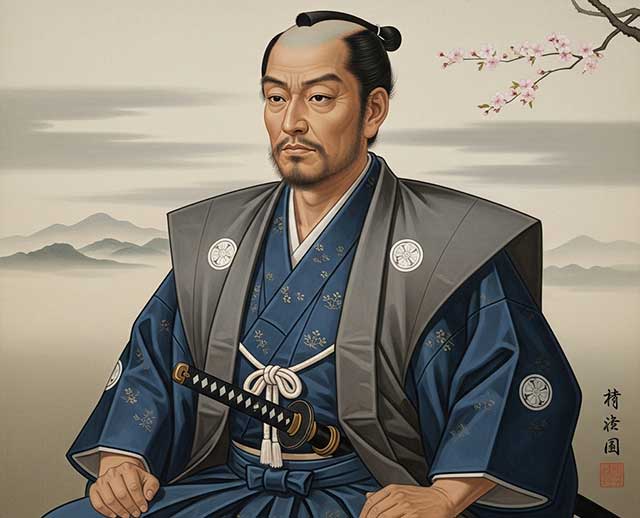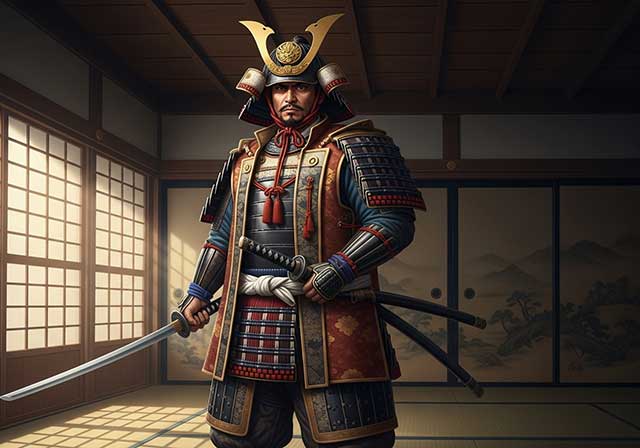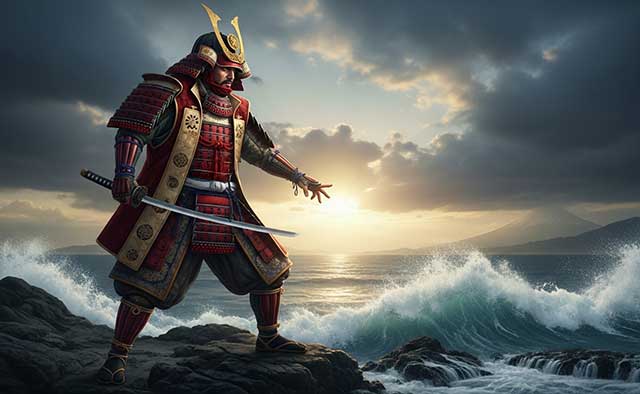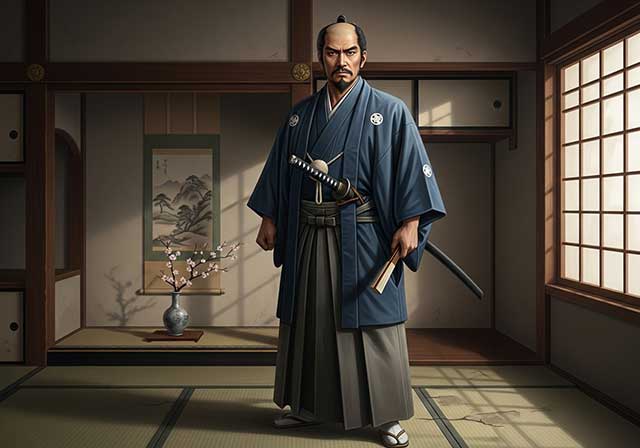
Norikage came from the ancient samurai clan of Asakura, whose members considered themselves descendants of Prince Kusakabe, son of Emperor Tenmu (631–686). He was the eighth son of daimyo Asakura Takakage and was named Kotaro in childhood. Over time, Asakura Norikage became the pillar of the Asakura clan and was undoubtedly its most talented commander during that difficult period when the clan was experiencing internal difficulties, uprisings by the Ikko-ikki sect, and instability in the lands surrounding the capital. Although Norikage himself was never a daimyo, he served as an advisor to three generations of Asakura clan leaders. He spent his entire life on military campaigns. After his father's death in 1481, Norikage entered the service of his brother, Asakura Ujikage.
After Ujikage's death, he was succeeded by his thirteen-year-old son Sadakage, Norikage's nephew. However, not all members of the clan agreed with this appointment, which by 1503 had resulted in the preparation of a conspiracy to change the clan leader. Asakura Kagefusa became the leader of the conspirators and asked Norikage to join the rebellion. Norikage pretended to agree, but only to expose the conspiracy. Thanks to his actions, the rebellion was thwarted, and the rebels' headquarters, located in Tsuruga Castle, was attacked by loyal daimyo. Kagefusa turned to the Hosokawa clan for help, but their detachment was intercepted near Lake Biwa on its way to the province of Etzen. Kagefusa managed to escape to Etzen, where he soon died of illness.
In 1506, Norikage defeated the Ikko-ikki forces at the Battle of Kujuryugawa. In 1517, he commanded an expedition to the Tango province. In 1526, Norikage led the Asakura army sent to aid the Asai clan in their fight against the Rokkaku clan, which strengthened the alliance between the Asai and Asakura clans. In 1527, at the request of Shogun Ashikaga Yoshiharu, he fought on the side of the shogunate in the Battle of Sensōjiguchi. In 1531, Norikage again fought against the Ikko-ikki, this time in Kaga Province.
In 1548, Norikage took monastic vows and took the name Soteki. However, neither age nor religion distracted him from his duty as a warrior. In 1555, at the age of seventy-nine, he once again led an army and went to Kaga Province, where he participated in his last campaign against the Ikko-ikki sectarians. After the assault on Daishōji-motete, he felt unwell, handed over command to Asakura Kagetaka, and returned to Itijōnodani, where he died on September 23.
Following his monastic vows, Norikage never married and had no children of his own, but he adopted his nephew Kagetoshi.
Norikage left behind a unique literary legacy, the Asakura Soteki Waki. This is a collection of Norikage's sayings, recorded by one of his closest vassals several years before his death. It includes eighty-three instructions written in the kanamajiri style. This work can be considered Norikage's spiritual testament, reflecting his practical experience and outlook on life. It is completely devoid of the idealism characteristic of previous and subsequent eras. “No matter what a warrior is called — a dog or a wild beast — the main thing for him is to win,” said Norikage. He argued that the fates of the lord and his vassals are one, so there must be harmony between them. Almost all of his teachings are aimed at achieving success in battle, although on the surface they may seem to be devoted to completely different things—morality, horse care, and so on. Undoubtedly, Norikage's advice is not theoretical musings, but ideas tested by personal experience and confirmed by his own life.
See also
-
Ouchi Yoshioki

Ouchi Yoshioki, the ruler of the provinces of Suo, Nagato, and Iwami, was one of the most capable military commanders and politicians of the late 15th and early 16th centuries. The son of Ouchi Masahiro, he governed from his residence in Yamaguchi in the province of Suo. In 1499, Yoshioki gave refuge to Shogun Ashikaga Yoshitane, who had been driven out of Kyoto by Hosokawa Masamoto. Shogun Yoshizumi, Masamoto’s protégé, ordered the lords of Kyushu to unite their forces against Yoshioki; however, they did not dare to do so, fearing the power of a man who by that time controlled six provinces. Having gathered a substantial army, Yoshioki marched from his native Suo toward Kyoto in order to restore Shogun Yoshitane to power.
-
Otomo Sorin

Ōtomo Yoshishige came from a noble lineage, being the eldest son of Ōtomo Yoshiaki, the ruler of Funai Province. The roots of the Ōtomo family traced back to Fujiwara Hidesato, the adopted son of Nakahara Chikayoshi. Fujiwara served Minamoto Yoritomo during the Genpei War and took part in battles in Mutsu Province in 1189. In 1193, he was appointed shugo of Buzen and Bungo Provinces, after which he adopted a new surname—Ōtomo.
-
Okudaira Sadamasa

Sadamasa was the son of Okudaira Sadayoshi and took part in several battles under Tokugawa Ieyasu, distinguishing himself in the Battle of Anegawa in 1570, where he took two heads. Around 1572 he was forced to enter the service of the Takeda clan, but after the death of Takeda Shingen in 1573 he returned to Tokugawa, leaving Tsukude Castle together with his men. As a result of this defection, Takeda Katsuyori ordered the execution of Sadamasa’s wife and brother, who were being held as hostages.
-
Okubo Tadatika

Tadatika, the son of Okubo Tadayō, entered the service of Tokugawa Ieyasu at the age of eleven, and took his first head in battle when he was sixteen. After the establishment of the Tokugawa shogunate, he was appointed as a rōjū — a senior bakufu official — and was regarded as one of Ieyasu’s most trusted advisors, alongside Honda Masanobu. He is also known for his military chronicle Mikawa Monogatari, which describes Ieyasu’s rise to power and the early years of the Tokugawa shogunate.
-
Okubo Nagayasu

Nagayasu was the second son of Okura Nobuyasu, a sarugaku theater actor from the Takeda clan. Takeda Shingen recognized the young man’s potential and took him into service, appointing him as a vassal to his general, Tsuchiya Masatsugu. During this period, Nagayasu changed his family name to Tsuchiya. He was entrusted with developing the Takeda clan’s gold mines as well as handling matters related to taxation.
-
Nitta Yoshisada

Nitta Yoshisada was a loyal soldier of Emperor Go-Daigo, who in the 1330s attempted to restore direct imperial rule in Japan. The Nitta family was related to the Ashikaga house and was older in lineage. However, they did not join Minamoto Yoritomo at the start of his war with the Taira, as the Ashikaga did, and therefore did not receive high positions in the Kamakura shogunate. This may have been one of the reasons why Yoshisada rose against the Hōjō clan in 1333.
-
Natsume Yoshinobu

Yoshinobu, a long-time vassal of the Matsudaira and Tokugawa clans, governed Hamamatsu Castle on behalf of the Tokugawa house. During the clashes between the Imagawa, Takeda, and Matsudaira clans, he served in the garrison of Nagasawa Castle and in 1562 took part in raids under the command of Itakura Shigezane. When, in 1563, a revolt of the Sōtō-shū sect followers broke out in Mikawa Province, Yoshinobu joined the rebels together with Honda Masanobu and Hachiya Sadatsugu.
-
Nambu Nobunao

The Nambu clan was an ancient and powerful family that traced its lineage back to the Minamoto shoguns and had controlled a significant part of the Tohoku region in northern Honshu since the 12th century. Nobunao was born in Ikatai Castle, located in what is now the city of Iwate. He was the second son of Ishikawa (Nambu) Takanobu, the 22nd head of the Nambu clan. In 1565, Nobunao’s uncle, Nambu Harumasa, adopted him, brought him to Sannohe Castle, and named him his heir, later giving his daughter in marriage to him.

